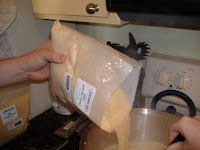 The professor and I went to the Mercato in Little Italy today in hot pursuit of a good farmer's market in San Diego. This quest comes on the heels of visiting, and enjoying, the Pike Place Market in Seattle and the Farmer's Market in Los Angeles. What I loved so much about these places was all the fresh fruit and veggies, just begging to be taken home, and the over zealous shopkeepers eagerly hoping you'll buy whatever it is they're selling. It's crowded, and smells funny, but there's something really comforting about these public markets. It's not just because most of the food is organically grown by local farmers, and it's not just because you get to try lots of free samples of infused olive oil and homemade hummus, although those are certainly valid reasons to go. (Note to vendors: I really, really would like to buy a $12 bottle of fancy olive oil from you but I can't justify the expense. Even if I did buy it, I'd feel guilty every time I used it since I know how much I paid for it so it would probably just sit in my cupboard untouched. Thanks for the sample, though. Note to readers: Infused olive oil makes a great gift.) I think it has to do with the fact that the people you're buying this stuff from actually made (or grew) it. When you go to the grocery store, the clerk doesn't know (or care) where the artichokes he's selling came from. At a farmer's market, those artichokes came from Joe's farm up north. Maybe I've read Fast Food Nation or In Defence of Food too many times, but I don't care.
The professor and I went to the Mercato in Little Italy today in hot pursuit of a good farmer's market in San Diego. This quest comes on the heels of visiting, and enjoying, the Pike Place Market in Seattle and the Farmer's Market in Los Angeles. What I loved so much about these places was all the fresh fruit and veggies, just begging to be taken home, and the over zealous shopkeepers eagerly hoping you'll buy whatever it is they're selling. It's crowded, and smells funny, but there's something really comforting about these public markets. It's not just because most of the food is organically grown by local farmers, and it's not just because you get to try lots of free samples of infused olive oil and homemade hummus, although those are certainly valid reasons to go. (Note to vendors: I really, really would like to buy a $12 bottle of fancy olive oil from you but I can't justify the expense. Even if I did buy it, I'd feel guilty every time I used it since I know how much I paid for it so it would probably just sit in my cupboard untouched. Thanks for the sample, though. Note to readers: Infused olive oil makes a great gift.) I think it has to do with the fact that the people you're buying this stuff from actually made (or grew) it. When you go to the grocery store, the clerk doesn't know (or care) where the artichokes he's selling came from. At a farmer's market, those artichokes came from Joe's farm up north. Maybe I've read Fast Food Nation or In Defence of Food too many times, but I don't care.So grab your reusable tote and bring it to the Mercato. It could just be the perfect inspiration for your next meal. This weekend we'll be having pancetta mixed with cherry tomatoes, fresh basil and pasta, and Sunday is jambalaya. And of course, there are fresh flowers on the table, which makes everything taste better.










